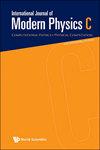On gap matching for lane-changing vehicles: coordinated strategies to improve traffic flow at weave bottlenecks
IF 1.6
4区 物理与天体物理
Q3 COMPUTER SCIENCE, INTERDISCIPLINARY APPLICATIONS
引用次数: 0
Abstract
The weaving section on the freeway will be an active bottleneck due to vehicles’ mandatory or discretionary lane-changing (LC) conflicts. In the early stages of the development of intelligent connected transportation, destination information collection of weaving vehicles is possible, which provides an opportunity to improve performance in weaving traffic. In this paper, a simulation system with coordinated strategies embedded to satisfy the LC needs is presented under the weaving traffic flow. First, an algorithm is proposed to evaluate the balance between the demand for LC vehicles and the available gaps provided in weaving traffic, which can be adjusted by variable speed limit (VSL) and ramp metering strategies. Second, to validate the proposed algorithm, a typical weave section with a merge and a diverge connected through a single auxiliary lane is researched, and a simulation platform based on cellular automata has been developed. The optimal control strategies are obtained by model predictive control (MPC) and taking the minimum travel time as an objective. Third, the advantages of coordinated control strategies are studied and discussed in traffic efficiency improvement and the success of LC proportions under different combinations of weaving ratios and large vehicle traffic mix.变道车辆间隙匹配:改善编织瓶颈交通流的协调策略
高速公路的交错路段由于车辆的强制或自主变道冲突将成为一个主动瓶颈。在智能互联交通发展的早期阶段,编织车辆的目的地信息采集是可能的,这为提高编织交通的性能提供了机会。本文提出了一种嵌入协调策略以满足交织交通流下LC需求的仿真系统。首先,提出了一种基于可变限速(VSL)和匝道计量策略的交叉交通中LC车辆需求与可用间隙平衡的评估算法;其次,为验证该算法的有效性,研究了一个典型的合并和发散通过单一辅助车道连接的编织路段,并开发了基于元胞自动机的仿真平台。以最小行程时间为目标,采用模型预测控制(MPC)方法获得最优控制策略。第三,研究和讨论了不同编织比组合和大车辆交通组合下协调控制策略在提高交通效率和LC比例成功度方面的优势。
本文章由计算机程序翻译,如有差异,请以英文原文为准。
求助全文
约1分钟内获得全文
求助全文
来源期刊

International Journal of Modern Physics C
物理-计算机:跨学科应用
CiteScore
3.00
自引率
15.80%
发文量
158
审稿时长
4 months
期刊介绍:
International Journal of Modern Physics C (IJMPC) is a journal dedicated to Computational Physics and aims at publishing both review and research articles on the use of computers to advance knowledge in physical sciences and the use of physical analogies in computation. Topics covered include: algorithms; computational biophysics; computational fluid dynamics; statistical physics; complex systems; computer and information science; condensed matter physics, materials science; socio- and econophysics; data analysis and computation in experimental physics; environmental physics; traffic modelling; physical computation including neural nets, cellular automata and genetic algorithms.
 求助内容:
求助内容: 应助结果提醒方式:
应助结果提醒方式:


